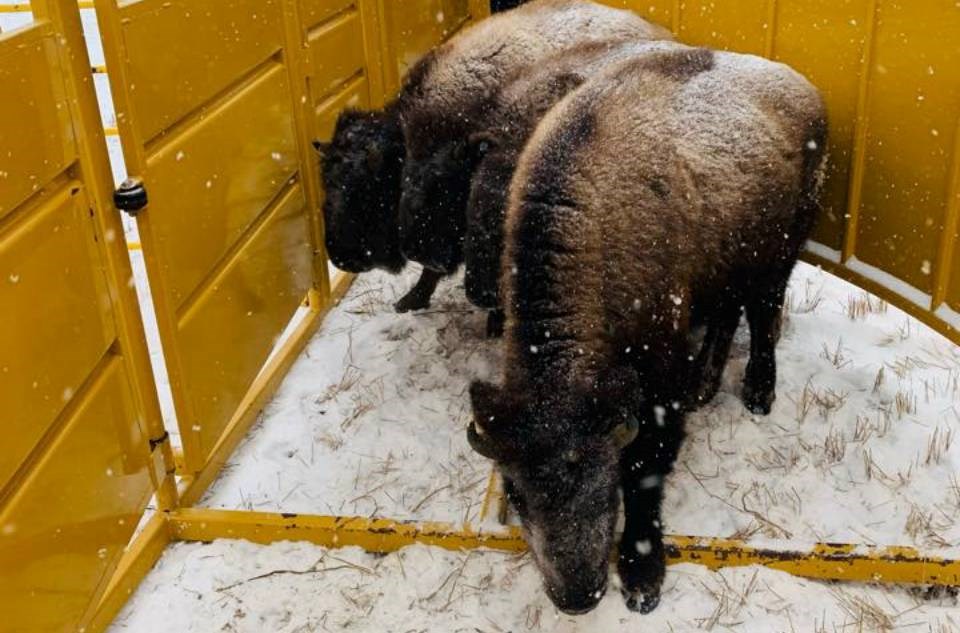A Crystal Falls farmer experienced some tense moments last winter when his herd of bison escaped their enclosure, roaming the West Nipissing area for weeks before being captured and returned home.
Eight of the animals, residents of The Bison Farm located about 45 minutes west of North Bay, got loose after severe winds blew down a tree, which destroyed a section of fence, sending the startled animals running.
“The bison travelled far from home and, unfortunately, one was killed when it was hit on the highway,” recalled Madeline Beaudry, president of the West Nipissing-Sudbury East Federation of Agriculture (OFA), during a recent online webinar.
“Luckily, the person was OK; however, the other bison were still on the loose.”
As it happens, the OFA and its partners had prepared for this exact type of situation just a few years earlier.
In 2019, the OFA, Springer Animal Hospital in Sturgeon Falls and Creative Meats, an abattoir in Markstay-Warren, partnered on the purchase of a portable cattle squeeze — a type of paddock that corrals cattle, gently restraining them to enable farmers to tag animals or perform other types of animal care.
The acquisition was made more affordable for the trio thanks to a grant from the Sustainable New Agri-food Products and Productivity (SNAPP) Program.
Administered by the Rural Agri-innovation Network (RAIN), the Northern Ontario Farm Innovation Alliance (NOFIA), and the Northwestern Ontario Innovation Centre, and funded by FedNor, SNAPP provides producers with funding for equipment and technology to help grow their operations.
Beaudry said the partners wanted a portable cattle squeeze in the event of an emergency in the area, which is known for its rich agricultural heritage.
“In the past, we had already seen a couple of situations with livestock on Highway 11 north; we saw when forest fires caused evacuations of some farms, how we really were not prepared in our area,” she said.
“We realized that the farming community really needs to be prepared for these challenges, and this equipment is very expensive and only required on occasion on the farm.”
There have been other challenges, Beaudry said.
Following a change to provincial cattle-tagging regulations, tagging could no longer be done at the local abattoir, and because there aren’t any tagging stations in the area, farmers were left without an easy way to tag their cattle.
In addition, having the proper equipment available helps large-animal veterinarians in doing their work faster and more safely, Beaudry added. It could even work as an incentive to attract new large-animal veterinarians to the area, which has seen a steady decline in the service.
Their decision proved prescient.
Last winter, after the bison were on the lam for several days, the portable cattle squeeze was put into action, Beaudry said.
A local group of people set it up in an area where the bison had been seen, placing a silage bale in the corral to lure the bison in. One farmer brought in an additional gate, which could be activated from a distance, and set it up at the entrance to a livestock trailer. The scheme worked.
“They managed to capture the bison without injury, and were able to load them onto the livestock trailer and return them to their farm,” Beaudry said.
That purchase of the cattle squeeze is a perfect example of how SNAPP can help Northern Ontario producers in their operations, noted Cathy Bouchard, a project coordinator at RAIN.
“It’s a program for Northern Ontario agri-food producers, businesses and communities who have unique challenges to grow their business through projects that create new products, or enhance productivity, strengthen value chains, or foster positive environmental benefits,” she said.
Eligible producers can apply to one of three SNAPP streams: new products, which is for businesses that are creating a new product for their business or region; productivity enhancement, which is for projects that increase efficiencies or processes in a business; and clean growth in agri-food, which is for projects that improve environmental performance while boosting productivity, growth and competitiveness.
“A big portion of the program is innovation and speaking to whether the project is innovative,” Bouchard noted.
That could mean something that’s innovative for Northern Ontario, or innovative within the business, she added.
Applications are be judged on whether the project is scalable.
“Will that project directly impact the agri-food sector in the North through job creation, business expansion, strategic alliances, that sort of thing?” Bouchard said.
Individual applicants can apply for up to $10,000 at a 50 per cent cost share, while collaborations of three parties or more — as in the case of the trio that purchased the portable cattle squeeze — can receive up to $25,000 at 50 per cent cost share.
Beaudry said that, in addition to helping corral bison last winter, the cattle squeeze has been made available for use by other farm associations in the area, the OPP, and government agencies that might need the equipment in an emergency.
SNAPP made it all possible, she said, and the partners are grateful for the funding.
“In our community, it was a time when many people came together, and it was a time when we really needed it, just after the pandemic, and it was a good story ending.”
The current SNAPP intake launched on Nov. 3 and will close on Jan. 13. Projects that receive funding must be completed by Dec. 31, 2023.
Details on the program, along with registration information, are available here.




